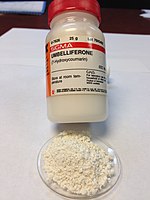Umbelliferone
This article needs additional citations for verification. (March 2020) |

| |

| |
| Names | |
|---|---|
| Preferred IUPAC name
7-Hydroxy-2H-1-benzopyran-2-one | |
| Other names
7-hydroxycoumarin, hydrangine, skimmetine, beta-umbelliferone
| |
| Identifiers | |
3D model (
JSmol ) |
|
| ChEBI | |
| ChEMBL | |
| ChemSpider | |
ECHA InfoCard
|
100.002.038 |
PubChem CID
|
|
| UNII | |
CompTox Dashboard (EPA)
|
|
| |
| |
| Properties | |
| C9H6O3 | |
| Molar mass | 162.14 g/mol |
| Appearance | yellowish-white crystalline odorless powder |
| Melting point | 230 °C (446 °F; 503 K) (decomposes) |
| -88.22·10−6 cm3/mol | |
Except where otherwise noted, data are given for materials in their standard state (at 25 °C [77 °F], 100 kPa).
| |
Umbelliferone, also known as 7-hydroxycoumarin, hydrangine, skimmetine, and beta-umbelliferone, is a natural product of the coumarin family.
It absorbs
It is a yellowish-white crystalline solid that has a slight solubility in hot water, but high solubility in ethanol.
Natural occurrences and name
Umbelliferone's name is from the
Umbelliferone occurs in many familiar plants from the
It is one of the components of asafoetida, the dried latex from the giant fennel (Ferula communis).
It is also found in
Biosynthesis
Umbelliferone is a
Chemical synthesis
Umbelliferone is traditionally synthesized using the Pechmann condensation, from resorcinol and formylacetic acid (generated from malic acid in situ).[7]
A newer synthesis uses
Ultraviolet fluorescence
Umbelliferone absorbs strongly at 300, 305 and 325
Uses
The ultraviolet activity of umbelliferone led to its use as a
Umbelliferone is a potent inhibitor of type 3
Derivatives
Umbelliferone is the parent compound for a large number of natural products.
.Umbelliferone 7-apiosylglucoside can be isolated from the root of Gmelina arborea.[9]
See also
References
- PMID 6403855.
- PMID 19081820.
- ^ "UMBELLIFERONE". www.chemicalland21.com. Retrieved 21 November 2011.
- PMID 26244074.
- PMID 10771205.
- S2CID 84525194. Archived from the originalon 2013-01-05. Retrieved 2010-06-26.
- ISBN 978-81-88237-33-3.
- PMID 12570693.
- .
Further reading
- Dean F (1963). Naturally Occurring Oxygen Ring Compounds. London: Butterworths. ISBN 978-0-408-26750-2.
- Joule J, Mills K (2000). Heterocyclic Chemistry (4th ed.). Oxford: Blackwell Science. ISBN 978-0-632-05453-4.
- Barton D, Nakanishi K, Meth-Cohn O, eds. (1999). Comprehensive Natural Products Chemistry. Vol. 2. Oxford: ISBN 978-0-08-043154-3.










